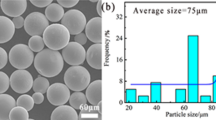Abstract
It is established that, in preparing p-Bi0.5Sb1.5Te3 by vertical zone melting, in addition to the directional texture (characteristic of materials exhibiting a highly anisotropic growth rate) in which the cleavage planes of crystal grains are parallel to the direction of propagation of the crystallization front, other texture types can arise, in which the orientation of grain cleavage planes is ordered in a cross-sectional plane of the ingot. Two types of such textures, “radial” and “circular,” were observed. In a radial texture, the lines of intersection of grain cleavage planes with a cross-sectional plane of the ingot are oriented along radii of this cross section and, in a circular texture, these lines of intersection are oriented approximately perpendicular to a radius crossing the grain. The formation of a radial texture is associated with rotation of the ampoule with the crystallizing substance about its vertical axis causing centrifugal flows of the melt. The formation of a circular texture is associated with the orientation effect of the ampoule walls and with circular motion of the melt during torsional oscillations of the ampoule about the vertical axis. Ingots with a radial texture exhibit much lower resistance to splitting along their axis than ingots with a circular texture do. An explanation is provided for this fact.
Similar content being viewed by others
References
U. Birkholz, Z. Naturforsch., A: Astrophys., Phys. Phys. Chem. 13, 780 (1958).
J. B. Drabble and C. H. L. Goodman, J. Phys. Chem. Solids 5, 142 (1958).
B. M. Gol’tsman, V. A. Kudinov, and I. A. Smirnov, Semiconductor Thermoelectric Materials Based on Bi 2 Te 3 (Nauka, Moscow, 1972) [in Russian].
W. A. Tiller, in Liquid Metals and Solidification (The American Society for Metals, Cleveland, OH, United States, 1958; Metallurgizdat Moscow, 1962).
Yu. G. Poltavtsev, Fiz. Tekh. Poluprovodn. (Leningrad) 9(11), 2074 (1975) [Sov. Phys. Semicond. 9 (11), 1356 (1975)].
A. R. Regel’ and V. M. Glazov, Physical Properties of Electronic Melts (Nauka, Moscow, 1980) [in Russian].
A. R. Regel’ and V. M. Glazov, Specific Features of the Formation of Electronic Melts (Nauka, Moscow, 1982) [in Russian].
Author information
Authors and Affiliations
Corresponding author
Additional information
Original Russian Text © B.M. Gol’tsman, V.A. Kutasov, L.N. Luk’yanova, 2009, published in Fizika Tverdogo Tela, 2009, Vol. 51, No. 4, pp. 706–708.
Rights and permissions
About this article
Cite this article
Gol’tsman, B.M., Kutasov, V.A. & Luk’yanova, L.N. Mechanism of formation of texture and its influence on the strength of thermoelectric p-Bi0.5Sb1.5Te3 . Phys. Solid State 51, 747–749 (2009). https://doi.org/10.1134/S1063783409040167
Received:
Published:
Issue Date:
DOI: https://doi.org/10.1134/S1063783409040167




